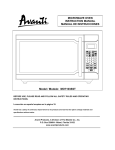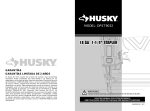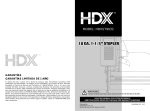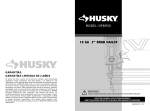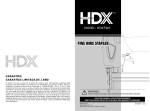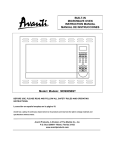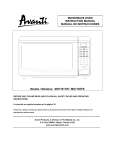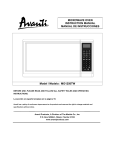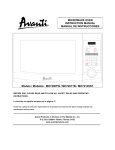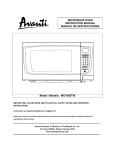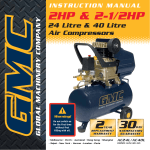Download Husky DPFIK Use and Care Manual
Transcript
MODEL: HDUFL50 GARANTÍAS GARANTÍAS LIMITADA DE 2 AÑOS Si dentro del año a partir de la fecha de compra, esta herramienta neumática Husky presentara dos falla debido a un defecto en los materiales o en la mano de obra, llame de inmediato al Centro de Servicio de Productos al 188-669-5672 (8 a.m. a 5 p.m. hora estándar del Este, de lunes a viernes, excepto días feriados). No devuelva la herramienta neumática a la tienda. Esté preparado para enviar el producto, franqueo prepagado, junto con una copia del recibo de compra con la fecha en la que se adquirió el producto y el modelo de la herramienta a: PRIME GLOBAL PRODUCTS, INC. Dirección: 201 Ropemill Parkway, suite#1, Woodstock, GA. 30188. Un producto defectuoso será reemplazado con uno nuevo de igual o mayor valor. Esta garantía excluye daños accidentales o resultantes y fallas debido a mal uso, abuso o desgaste debido al uso normal. Esta garantía le otorga derechos específicos, pero podría tener también otros derechos que varían según el estado. Llame al 1-888-669-5672 para más información. 26-Sp WARNING: Failure to follow warnings could result in DEATH OR SERIOUS INJURY. SAVE THIS MANUAL FOR FUTURE REFERENCE KEEP YOUR DATED PROOF OF PURCHASE FOR WARRANTY PURPOSES Distributed By: Home Depot U.S.A., Inc. 2455 Paces Ferry Rd, N.W. Atlanta, GA 30339 IMH300400AV-E/S 04/11 GENERAL SAFETY RULES P3 UNPACKING P5 FEATURES P5 OPERATION ● In this manual, on the labels, packages and all other information provided with this tool. The following signal words and meanings are intended to explain the levels of risk associated with this tool. SYMBOLS SIGNAL MEANING Indicates a potentially hazardous situation, which, if not avoided, could result in death or serious injury. Indicates a potentially hazardous situation, which, if not avoided, may result in minor or moderate injury. (Without symbol) Indicates a situation that may result in property damage. LOADING CLEAT NAILS P6 ! WARNING: LOADING STAPLES P6 ! CAUTION: UNLOADING CLEAT NAILS AND STAPLES P6 CHANGE THE FOOT PLATE P6 ADJUSTING THE FRONT FOOT P7 SETTING THE AIR PRESSURE P7 OPERATING THE TOOL P8 CLEARING JAMS P8 MAINTENANCE P9 RECOMMENDED HOOKUP P10 TROUBLE SHOOTING P11 WARRANTIES P12 CAUTION: GENERAL SAFETY RULES IMPORTANT SAFETY INSTRUCTIONS INSTRUCTIONS PERTAINING TO A RISK OF FIRE, ELECTRIC SHOCK, OR INJURY TO PERSONS To reduce the risks of electric shock, fire, and injury to persons, read all the instructions before using the tool. ! WARNING: When using tools, basic precautions should always be followed, including the following: WARNING: The warnings and precautions discussed in the manual cannot cover all possible conditions and situations that may occur. It must be understood by the user that common sense and caution are factors which cannot be built into this product, but must be supplied by the user. CALIFORNIA PROPOSITION 65 ! WARNING: SAVE THIS MANUAL Keep this manual for the safety warnings, precautions, operations, inspections and maintenance. Keep this manual and the receipt in a safe and dry place for future reference. SYMBOLS ! WARNING: To avoid serious personal injury, do not attempt to use this product until you read the manual thoroughly and understand it completely. Save this manual and review frequently for continuing safe operation and instructing others who may use this ● Some of the following symbols may be used on this tool. Please study them and learn their meaning. Proper interpretation of these symbols will allow you to operate the tool better and safer. Read operator's manual : To reduce the risk of injury, user must read and understand operator's manual before using this product. Risk to hearing: Always wear ear protection when using this tool. Failure to do so may result in hearing loss. Eye protection: Always wear safety goggles, safety glasses with side shields, or a full face shield when operating this product. WDH100401AV-S 10/10 Risk of serious personal injury: Never place hands or any other body parts in the fastener discharge area of the nailer. The tool might eject a fastener and could result in death or serious personal injury. 02 This product or its power cord may contain chemicals known to the State of California to cause cancer and birth defects or other reproductive harm. Wash hands after handling. WORK AREA Keep the work area clean and well lighted. Cluttered benches and dark areas increase the risks of accidents. Do not operate the tool in explosive atmospheres, such as in the presence of flammable liquids, gases, or dust. The tool creates a spark which may ignite flammable liquids, gases or dust. Keep bystanders, children, and others away while operating the tool. Distractions could result in improper use and cause injury. Avoid unintentional misfires. Always use caution to avoid accidentally firing. Do not point towards yourself or anyone whether it contains fasteners or not. PERSONAL SAFETY Always wear eye protection. Operator and others in the work area should always wear ANSI-approved safety goggles with side shields. Eye protection is used to guard against flying fasteners and debris, which may cause severe eye injury. You can use the goggles packed with the tool. Always wear hearing protection when using the tool. Prolonged exposure to high intensity noise may cause hearing loss. Use safety equipment. A dust mask, non-skid safety shoes and a hard hat must be used for the applicable conditions. Wear a full face shield if you are producing metal filings or wood chips. Dress properly. Do not wear loose clothing or jewelry. Contain long hair. Keep your hair, clothing, and gloves away from moving parts. Loose clothes, jewelry, or long hair can be caught in moving parts. Avoid unintentional starting. Be sure the switch (hammer cap) is off before connecting to the air supply. Do not carry the tool with your finger on the switch (hammer cap) or connect the tool to the air supply with the switch (hammer cap) on. Stay alert, watch what you are doing and use common sense when operating a power tool. Do not use tool while tired or under the influence of drugs, alcohol, or medication. A moment of inattention while operating the tool may cause serious injury. Do not overreach. Keep proper footing and balance at all times. Proper footing and balance enables better control of the tool in unexpected situations. 03 Make sure the hose is free of obstructions or snags. Entangled or snarled hoses can cause loss of balance or footing and may become damaged, resulting in possible injury. Do not attach the hose or tool to your body. Attach the hose to the structure to reduce the risk of loss of balance if the hose shifts. Always assume that the tool contains fasteners. Do not point the tool toward yourself or anyone whether it contains fasteners or not. ! WARNING: Do not nail on top of another nail. This is able to cause the nail to be deflected and hit someone, or cause the tool to react and result in a risk of injury to persons. ! WARNING: Remove finger from the hammer cap when not driving fasteners. Never carry the tool with finger on hammer cap, the tool is able to fire a fastener. TOOL USE AND CARE ! WARNING: Disconnect the tool from the air source before making adjustments, doing tool maintenance, clearing jams, leaving work area, or unloading the tool. Such precautionary measures reduce the risk of injury to persons. Know this tool. Read manual carefully, learn its applications and limitations, as well as the specific potential hazards related to this tool. Use only fasteners that are recommended for your models. Do not use the wrong fasteners or load the fasteners incorrectly. Use only accessories that are identified by the manufacturer for the specific tool model. Use of unauthorized parts or failure to follow maintenance instructions may create a risk of injury. Use only those fasteners recommended for use with this tool. Fasteners not identified for use with this tool by the tool manufacturer are able to result in a risk of injury to persons or tool damage when used in this tool. 04 Check for misalignment or binding of moving parts, breakage of parts, and any other condition that may affect the tool's operation. If damaged, have the tool serviced before using. Many accidents are caused by poorly maintained tools. There is a risk of bursting if the tool is damaged. Maintain tools with care. Keep tool clean. A properly maintained tool, reduces the risk of binding and is easier to control. Store tools out of the reach of children and other untrained people when it is idle. Tools are dangerous in the hands of untrained users. Check operation of the tool before use. Do not force tool. Use the correct tool for your application. The correct tool will do the job better and safer at the rate for which it is designed. Use clamps or another practical way to secure and support the workpiece to a stable platform. Holding a tool by hand or against the body is unstable and may lead to loss of control. Keep the tool and its handle dry, clean and free from oil and grease. Always use a clean cloth when cleaning. Never use brake fluids, gasoline, petroleum-based products, or any strong solvents to clean your tool. Do not use the tool as a hammer. Never use this tool in a manner that could cause a fastener to be directed toward anything other than the workpiece. Always carry the tool by the handle. Never carry the tool by the air hose. Do not use the tool if it leaks air or does not function properly. Do not operate the tool if it does not contain a legible warning label. Do not use the tool if the switch (hammer cap) does not turn the tool on or off. Any tool that cannot be controlled with the switch is dangerous and must be repaired. TOOL SERVICE Use only accessories that are identified by the manufacturer for the specific tool model. Use of unauthorized parts or failure to follow maintenance instructions may create a risk of injury. Use only the lubricants supplied with the tool or specified by the manufacturer. Tool service must be performed only by qualified repair personnel. When servicing a tool, use only identical replacement parts. Use only authorized parts. OPERATION Do not drive fasteners near edge of material. The workpiece may split causing the fastener or ricochet, injuring you or people around. Do not drive fasteners on top of other fasteners or with the tool at an overly steep angle as this may cause deflection of fasteners which could cause injury. Do not actuate the tool unless you intend to drive a fastener into the workpiece. Always handle the tool with care: ◆Respect the tool as a working implement. ◆Never engage in horseplay. ◆Keep others a safe distance from the tool while tool is in operation as accidental actuation may occur, possibly causing injury. AIR SUPPLY AND CONNECTIONS The connector on the tool must not hold pressure when air supply is disconnected. If an incorrect fitting is used, the tool can remain charged with air after disconnecting and thus will be able to drive a fastener even after the air line is disconnected, possibly causing injury. Never use oxygen, combustible gases or bottled gasses as a power source for this tool. explosion may occur, causing injury or death. Never connect with an air compressor which can potentially exceed 200 Psi. Over pressurizing the tool is able to result in bursting, abnormal operation, breakage of the tool or serious injury to persons. Use only clean, dry, regulated compressed air at the rated pressure or within the rated pressure range as marked on the tool. Always verify prior to using the tool that the air source has been adjusted to the rated air pressure or within the rated air-pressure range. Always disconnect air resource: Before unloading or making adjustments. When maintaining the tool. When clearing a jam. When touching the safety yoke. When tool is not in use. When moving to a different work area. Such precautionary measures reduce the risk of injury to persons. SAVE THESE INSTRUCTIONS LOADING TOOL Do not load the tool with fasteners when any one of the operating controls is activated. Never place a hand or any part of body in fastener discharge area of tool. Never point tool at anyone. ! WARNING: The warnings and precautions discussed above cannot cover all possible conditions and situations that may occur. It must be understood by the user that common sense and caution are factors which cannot be built into this product, but must be supplied by the user. UNPACKING This tool has been shipped completely assembled. Make sure that all items listed in the packing list are included. Carefully remove the tool and any accessories from the box. Inspect the tool carefully to make sure no breakage or damage occurred during shipping. Do not discard the packing material until you have carefully inspected and satisfactorily operated the tool. If any parts are damaged or missing, please call 1-888-669-5672. PACKING LIST 3 In 1 flooring nailer Color box Mallet Air connector(pre-attached) Adjustment tools Lubrication oil Anti-dust cap(pre-attached) 5/8" foot plate Instruction manual Safety goggles ! WARNING: If any parts are missing do not operate this tool until the missing parts are replaced. Failure to do so could result in possible serious personal injury. 05 FEATURES ! WARNING: Do not attempt to modify this tool or create accessories not recommended for use with this tool. Any such alteration or modification is misuse and could result in hazardous condition leading to possible serious personal injury. FEATURES REVOLUTIONARY 3 IN 1 DESIGN For use with Staples, T-Cleats and L-Cleats. NO-MAR DESIGN Provides increased protection from marring when working with a finished flooring surface. ANODIZED ALUMINUM MAGAZINE For long lasting durability. DURABLE CONSTRUCTION Light weight and durably constructed of highstrength aluminum and heat treated steel parts. AIR FILTER Keeps interior components debris free, extending tool life. MALLET INCLUDED SPECIFICATIONS Operation pressure: Nails capacity: Tool weight: Air inlet: Fasteners: 70-115psi L: 100pcs T: 100pcs U: 90pcs 10.25 lbs 1/4"NPT 1-1/2" to 2" OPERATION 16Ga. 15-1/2 Ga. Compatible with Generic Brands 1/2" Staples, T-Cleats, & L-Cleats. ! WARNING: The tool may fire when it is first connected to the air resource. Always connect the tool to the air resource before loading fasteners to prevent injury from unintended cycling. ⒈Pull the Pusher(A) back to the end of magazine. Lock pusher in the place by using Lock button(C). Then pull the Magazine side shelter(B) back. ⒉Place a full clip of 1/2" Crown Staples in the magazine from the top. Up to 90pcs can be loaded into the tool. ⒊Press the Lock button(C), then the Pusher(A) sets back to make the Magazine side shelter(B) down back. LOADING CLEAT NAILS ! WARNING: Use only those fasteners recommended for use with this tool. Fasteners not identified for use with this tool by the tool manufacturer are able to result in a risk of injury to persons or tool damage when used in this tool. ⒈ Pull the Pusher(A) back to the end of magazine. Lock pusher in the place by using the Lock button(C). Then pull the Magazine side shelter(B) back. ⒉ Place full clip of desired Fasteners into magazine from the side. Up to 100 cleat nails can be loaded into magazine. Be noted that, when loading the L cleat nails, the side with the L head should be in the left of the Magazine side shelter(B). Press the Lock button(C), then the Pusher(A) set back to make the Magazine side shelter(B) down back. Magazine side shelter (B) Lock button (C) CHANGE THE FOOT PLATE Pusher (A) UNLOADING CLEAT NAILS AND STAPLES Unloading is the reverse of loading. Always disconnect the air resource before unloading. ! WARNING: Always unload all fasteners before removing tool from service. 06 ! WARNING: The tool may fire when it first connected to the air resource. Always connect the tool to the air resource before loading fasteners to prevent injury from unintended cycling. Always make sure the tool's magazine is empty at the beginning of each work session, before connecting to an air resource. ! WARNING: The tool may fire when it is first connected to the air resource. Always connect the tool to the air resource before loading fasteners to prevent injury from unintended cycling. 16Ga. LOADING STAPLES The tool is equipped with a factory pre-installed 3/4" foot plate(D). And an additional uninstalled 5/8" foot plate. To change the plate: ⒈ Disconnect the tool from the air resource. ⒉ Empty the magazine completely. ⒊ Fire the tool into a piece of scrap wood to ensure there is no compressed air or fasteners left in the tool. ⒋ Set the tool on its side to expose the four screws(E). ⒌ Remove the four screws(E), then, remove the foot plate. ⒍ Align the four screw holes in the replacement foot plate with the four threaded mounting holes. ⒎ Using the four screws you removed just now, secure the replacement foot plate to the tool. ⒏ Ensure the correct Foot Plate is installed by firing into a scrap piece of flooring and checking for proper fastener placement. 07 OPERATING THE TOOL ! WARNING: Disconnect the tool from the air source whenever changing the foot plate. Make sure there is no fastener in the magazine before changing the foot plate. ⒈ Attach the tool to the air resource. Start your compressor and check the pressure, making sure it is set between 70-115psi. Do not exceed the maximum115psi. 2. Hold the Hand grip(J) securely and Press the Foot plate(D) to the work surface. Make sure the plate is over the fastener target position. 3. Press down hard so that the foot plate is firmly contacting the work surface. Then, using the mallet packed with the Tool, strike the hammer cap(K) firmly to drive the fastener into work surface. Lift the tool off the work surface. Repeat this process until the job is completed. 4. When finished, make sure to store the tool in a clean, dry, safe location out of reach of children and other unauthorized People. Bolts(G) Front Foot (F) Small Plate (H) Screws(E) ! WARNING: An improperly functioning tool must not be used. Do not actuate the tool unless the tool is placed firmly against the work piece. NOTE: Make sure the Hammer Cap on the flooring nailer is in the up position before adding the air hose, if not, the nailer may cycle(See below): Hammer Cap(Up Position) Hammer Cap (Down Position) ! WARNING: Foot plate(D) Adjust groove(I) Adjust groove(I) ! WARNING: ADJUST THE FRONT FOOT The tool is equipped with an adjustable front foot, can be adjusted for 3/4"-5/8" wood floors. This tool is shipped out set for 3/4" wood floor. To adjust the front foot (F): 1. Disconnect the tool from the air resource. 2. Empty the magazine completely. 3. Fire the tool into a piece of scrap wood to ensure. There is no compressed air or fasteners left in the tool. 4. Set the tool on its side to expose the two Bolts(G) and two Small Plates(H). 5. Loose these two Bolts (G) and two Small Plates (H) to ensure move the Front Foot(F) in the range of the Adjust Groove(I). 6. Adjust the proper position of the Front Foot(F) according to the actual thickness of wood floors and then lock tightly these two Bolts(G) and two Small Plates(H). 7. Ensure the correct front foot set for te wood floor by firing into a scrap piece of flooring and checking for proper fastener placement. 08 Disconnect the tool from the air source whenever changing the foot plate. Make sure there is no fastener in the magazine before changing the foot plate. Extreme caution must be used whenever this tool is connected to an air resource. If the tool is dropped, or if the Hammer cap(K)is accidentally struck, then the tool will fire a fastener, potentially causing SERIOUS PERSONAL INJURY. ! WARNING: Keep your feet off the tool. ! WARNING: Before using the tool on a floor, test the tool on a scrap piece of wood. Adjust the driving depth by providing more or less air pressure. Never exceed 115PSI. SETTING THE AIR PRESSURE The amount of air pressure required depends on the size of the fasteners and the workpiece material. Begin testing the depth of drive by driving a test nail into the same type of workpiece material used for the actual job. Drive a test fastener with the air pressure set at 9095psi. Raise or lower the air pressure to find the lowest setting that will perform the job with consistent results. Hammer Cap (K) Hand grip (F) CLEARING JAMS Occasionally, fasteners may become jammed in the firing mechanism of the tool, making the tool inoperable. To remove a jammed fastener, follow the steps below: ⒈ Disconnect the tool from air resource. 2. Empty the magazine. Make sure all fasteners are removed. 3. Try to fire the tool into a piece of scrap wood or flooring to make sure that it's incapable of firing any fasteners. 4. Set the tool on its side to expose the two Bolts (G) and two Small Plates(H)under the screws. 5. Removed these Nose Bolts(G) and two Small Plate(H). Three Nose Bolts(L) can be seen after removing the Front Foot(F). 6. Remove three Nose Bolts(L), slide the Driver Guide (M) out to expose the jammed fastener. 7. Remove jammed fastener, using plier or a screwdriver if required. 8. Replace the Driver Guide(M) and Nose Bolts (L) 9. Replace the Front Foot (F), Plate (H) and bolts (G) back. 10.Reload the tool with fasteners, then reconnect the air resource to the tool. 11.Press the Drive guide (M) against a piece of wood, and test fire the fasteners several times to check for proper operation. If the tool is properly firing, you may continue using the tool. If the tool fails to perform properly, immediately discontinue use and have the tool repaired by a qualified service technician. 09 ! WARNING: Make sure there is no fastener in magazine before clearing a jam. the ⒈ Disconnect the air supply from the tool to add lubricant. CAUTION: Lubricate tool only with specified lubricants. CLEANING Nose Bolts (L) Avoid using solvents when cleaning plastic parts. Most plastics are susceptible to damage from various types of commercial solvents and maybe damaged by their use. Use clean cloths to remove dirt, dust , oil, grease, etc. Driver guide (M) 2. Turn the tool so the air inlet is facing up. Place 23 drops of pneumatic fastening tool oil into air inlet. Do not use detergent oils, oil additives, or air -tool oils. Do not use detergent oil or additives as these lubricants will cause accelerated wear to the seals and bumpers in the tool, resulting in poor tool performance and frequent tool maintenance. ! WARNING: Do not at any time let brake fluids, gasoline, petroleum-based products, penetration oils, ect. come in contact with plastic parts. Chemicals can damage, weaken or destroy plastic which may result in serious personal injury. RECOMMENDED HOOKUP 1.The air compressor must be able to maintain a minimum of 70 psi when the tool is being used. 2.An inadequate air supply can cause a loss of power and inconsistent driving. An oiler can be used to provide oil circulation through the tool. A filter can be used to remove liquid and solid impurities which can rust or gum up internal parts of the tool. 3.Always use air supply hoses with a minimum working pressure rating equal to or greater than the pressure from the power source if a regulator fails, or 150 psi, whichever is greater. Use 3/8" air hose for runs up to 50'. Use 1/2" air hoses for 50' run or longer. For better performance, install a 3/8" quick plug (1/4" NPT thread) with an inside diameter of 0.315" (8mm) on the tool and 3/8" quick coupler on the air hose. 4.Use a pressure regulator on the compressor, with an operating pressure of 0-125 psi. A pressure regulator is required to control the operating pressure of the tool between 70 and 115 psi. COLD WEATHER OPERATION For cold weather operation, near and below freezing, the moisture in the air line may freeze and prevent tool operation. We recommend the use of air tool lubricant or permanent antifreeze (ethylene glycol) as a cold weather lubricant. MAINTENANCE ! WARNING: Any time inspection, maintenance, and cleaning are done: ◆Disconnect the tool from the air resource. ◆Empty the magazine completely. ANTI-DUST CAP Each tool is packed with an anti-dust cap on the air connector, check it after unpacking. Keep the antidust cap to cover the air connector when the tool is not in use to prevent debris from entering the tool. CAUTION: The air compressor must be able to maintain a minimum of 70psi when the tool is being used. An inadequate air supply can cause a loss of power and inconsistent driving. CAUTION: 3.After adding oil, run too briefly. Wipe off any excess oil from the cap exhaust. Do not store tools in a cold weather environment to prevent frost or ice formation on the tools' operating valves and mechanisms that could cause tool failure. ! WARNING: Do not connect with an air compressor which can potentially exceed 200psi. As tool may burst, possibly causing injury. LUBRICATION Frequent, but not excessive, lubrication is required for best performance. Oil for the tool added through the air line connection add will lubricate the internal parts. Do not detergent oil or additives as these lubricants will cause accelerated wear to the seals and bumpers in the tool, resulting in poor tool performance and frequent tool maintenance. 10 11 TROUBLE SHOOTING ! WARNING: Stop using tool immediately if any of the following problems occur. Serious personal injury could result. Any repairs or replacements must be done by a qualified service person or an authorized service center. PROBLEMS POSSIBLE CAUSES CORRECTION ACTIONS Air leaking in head cap. ⒈Loose screws. ⒉Worn or damaged O-rings or seals. ⒈Tighten screws. ⒉Install overhaul kit. Lack of power. Slow to cycle. ⒈Tool is too dry. ⒉Air pressure too low. ⒊Exhaust blocked. ⒈Add about 2-3 drops of lubrication into the air connector. ⒉Make sure the air compressor is set between 70psi and 115psi. ⒊Clean exhaust channel. Not shooting fasteners . ⒈Damaged pusher spring. ⒉Wrong size of fasteners. ⒈Replace spring. ⒉Use 1/2" crown staples or 1-1/2" to 2"nails. Fasteners are jammed in the tool frequently. ⒈Drive channel is worn. ⒉Piston is broken or worn. ⒊Bent fasteners. ⒋Dirty magazine. ⒌Loose magazine. ⒍Wrong fasteners. ⒈Fix the drive channel. ⒉Replace the piston. ⒊Remove the bent fasteners, replace with the 1/2"crown staples or 1-1/2" to 2"nails. ⒋Clean magazine. ⒌Tighten screws. ⒍Verify that fasteners are the correct size. WARRANTY 2 YEARS LIMITED WARRANTY If within two years from the date of purchase, this Husky air tool product fails due to a defect in materials or workmanship, please immediately contact Product Support at 1-888-6695672 (8am to 5pm EST, M-F, except normal Holiday).Do not return the air tool to the store. Please be prepared to send the product, postage prepaid, along with a copy of the dated first owner purchase receipt with the tool model to: PRIME GLOBAL PRODUCTS, INC. Address:201 Ropemill Parkway, suite#1, Woodstock, GA. 30188. A defective product will be promptly replaced with a new one of equal or greater value. This warranty excludes incidental/consequential damages and failures due to misuse, abuse or normal wear and tear. This warranty gives you specific rights, and you may also have other rights, which vary, from state to state. Please call 1-888-669-5672 for details. 12 13 MODELO: HDUFL50 NORMAS GENERALES DE SEGURIDAD P14 DESEMBALAJE P16 CARACTERÍSTICAS FUNCIONAMIENTO P17 CÓMO CARGAR LISTONES P17 CÓMO CARGAR GRAPAS P17 CÓMO CARGAR LISTONES LOS GRAPAS P18 CÓMO CAMBIAR LA PLACA BASE P18 CÓMO AJUSTAR LA PATA FRONTAL P19 CÓMO CONFIGURAR LA PRESIÓN DE AIRE P19 CÓMO USAR LA HERRAMIENTA P19 CÓMO RETIRAR SUJETADORES ATASCADOS P21 MANTENIMIENTO P21 CONEXIÓN RECOMENDADA P23 SOLUCIÓN DE PROBLEMAS P24 GARANTIAS P25 ADVERTENCIA: Las advertencias y precauciones mencionadas en este manual no cubren todas las condiciones y situaciones posibles que pudieran ocurrir. El usuario debe comprender que el sentido comun y la precaucion son factores que no se pueden incorporar con el producto, sino que deben ser suministrados por el usuario. GUARDAR ESTE MANUAL Guarde este manual como referencia para las advertencias de seguridad, precauciones, el funcionamiento, las inspecciones y el mantenimiento. Guarde este manual y el recibo de compra en un lugar seguro y seco para referencia futura. SÍMBOLOS ! ADVERTENCIA: Para evitar lesiones personales graves, no intente usar este producto hasta que haya le do y comprendido completamente el manual. Guarde este manual y consultelo frecuentemente para utilizar la herramienta de forma segura y para instruir a otras personas para que puedan utilizarla. Algunos de los siguientes símbolos pueden ser utilizados en esta herramienta. Por favor, estudiarlos y aprender su significado. Una correcta interpretación de estos símbolos le permitirá utilizar la herramienta mejor y más seguro. ADVERTENCIA: No seguir las advertencias correctamente puede causar LA MUERTE O LESIONES GRAVES. GUARDA ESTE MANUAL PARA CONSULTARLO EN EL FUTURO. GUARDE SU COMPROBANTE DE COMPRA CON FECHA PARA FINES DE LA GARATÍA. Distribuido Por: Home Depot U.S.A., Inc. 2455 Paces Ferry Rd, N.W. Atlanta, GA 30339 Lea el manual del operador de: Para reducir el riesgo de lesiones, el usuario debe leer y entender el manual del operador antes de usar este producto. Protección de los ojos: Use siempre gafas de seguridad, gafas de seguridad con protección lateral o una careta completa cuando utilice esta producto. El riesgo a la audición: Siempre use protección para los oídos cuando se utiliza este tool. Failure lo contrario, podría resultar en la pérdida de audición. WDH100401AV-S 10/10 Riesgo de lesiones personales graves: Nunca coloque las manos o cualquier otra parte del cuerpo en la zona de descarga del sujetador de la clavadora. La herramienta puede expulsar un sujetador y puede causar la muerte o lesiones graves. 14-Sp En este manual, en las etiquetas, los embalajes y en toda la información incluida con esta herramienta, se usan las siguientes indicaciones y sus significados para explicar los niveles de riesgo asociados a esta herramienta. SÍMBOLOS INDICACIÓN SIGNIFICADO ! ADVERTENCIA: Indica una situación potencialmente peligrosa que, de no evitarse, puede ocasionar la muerte o lesiones graves. ! PRECAUCIÓN: PRECAUCIÓN: Indica una situación potencialmente peligrosa que, de no evitarse, puede ocasionar lesiones menores o moderadas. (Sin símbolo) Indica una situación que puede ocasionar daños en la propiedad. NORMAS GENERALES DE SEGURIDAD INSTRUCCIONES DE SEGURIDAD IMPORTANTES INSTRUCCIONES EN REFERENCIA AL PELIGRO DE INCENDIOS, CHOQUE ELECTRICO O LESIONES PERSONALES Para reducir los riesgos de choque eléctrico, incendio y lesiones personales, lea todas las instrucciones antes de usar la herramienta. ! ADVERTENCIA: AREA DE TRABAJO Mantenga el área de trabajo limpia y bien iluminada. Los bancos de trabajo desordenados y las áreas oscuras aumentan el riesgo de accidentes. No utilice la herramienta en atmósferas en las que exista riesgo de explosión, como por ejemplo en presencia de líquidos inflamables, gases o polvo. La herramienta produce una chispa que podría encender líquidos inflamables, gases o polvo. Mantenga a los transeúntes, niños y a otras personas alejadas cuando esté utilizando la herramienta. Las distracciones podrían resultar en el uso inapropiado y causar lesiones. Evite los disparos accidentales. Siempre tenga precaución para evitar disparos accidentales. No apunte la herramienta hacia usted u otra persona, aun cuando no contenga sujetadores. Cuando se usen herramientas, siempre se deberan seguir precauciones basicas, incluyendo las siguientes: PROPOSICIÓN 65 DE CALIFORNIA ! ADVERTENCIA: Este producto, a su cordón eléctrico, puede contener productos quimicos conocidos por el estado de California como causantes de cáncer y defectos de nacimiento u otros daños reproductiveos. Lave sus manos después de usar. 15-Sp SEGURIDAD PERSONAL Use siempre lentes de protección. El operador y cualquier otra persona que esté en el área de trabajo deben usar siempre gafas de seguridad con protecciones laterales aprobadas por las normas ANSI. Los lentes de protección se usan para evitar que los sujetadores o los desperdicios que se expulsen puedan causar una lesión ocular grave. Puede usar las gafas que se incluyen con la herramienta. Use siempre protección para los oídos cuando utilice esta herramienta. La exposición prolongada a ruidos de alta intensidad puede causar la pérdida de la audición. Utilice equipo de seguridad. Se deben utilizar una máscara de polvo, zapatos de seguridad antideslizantes y un casco para las condiciones aplicables. Use una máscara que cubra completamente su rostro si está produciendo partículas metálicas o astillas de madera. Use ropa adecuada. No use ropa holgada o joyas. Tómese el cabello largo. Mantenga el cabello, ropa y guantes lejos de las piezas en movimiento. Las ropas holgadas, joyas o el cabello largo pueden quedar atrapados en las piezas en movimiento. Cuidado con disparos accidentales. Quiten la cappa de plastico que cubre la coneccion de aire. No cargen la grapadora con su dedo en el la barilla o conecten la grapadora con la cappa de plastico. Manténgase alerta, preste atención a lo que hace y utilice el sentido común cuando utilice una herramienta eléctrica. NO utilice la herramienta si está cansado o bajo la influencia de drogas, alcohol o medicamentos. Un momento de desatención mientras utiliza la herramienta puede causar lesiones graves. No se extienda demasiado. Mantenga un apoyo de pies y un equilibrio adecuados en todo momento. Un apoyo de pies y equilibrio adecuados permiten un mejor control de la herramienta en situaciones inesperadas. No la use si está parado sobre una escalera u otra superficie inestable. Un apoyo de pies estable sobre una superficie sólida permite un mejor control de la herramienta en situaciones inesperadas. Asegúrese de que la manguera esté libre de obstrucciones o enganches. Las mangueras enredadas o enganchadas pueden causar la pérdida de equilibrio o del apoyo de pies y podrían dañarse y causar posibles lesiones. No fije la manguera o herramienta a su cuerpo. Fije la manguera a la estructura para reducir el riesgo de pérdida de equilibrio en caso que la manguera se mueva. Siempre dé por sentado que la herramienta contiene sujetadores. No apunte la herramienta hacia usted u otra persona, aun cuando no contenga sujetadores. ! ADVERTENCIA: No clave sobre otro clavo. Esto puede causar que el clavo se desvíe y alcance a alguien, o que la herramienta reaccione de alguna manera y lesione a alguien. ! ADVERTENCIA: Retire el dedo del Tapa del martillo cuando no coloca sujetadores. Nunca transporte la herramienta con el dedo en el Tapa del martillo, ya que la herramienta puede disparar un sujetador. USO Y CUIDADO DE LA HERRAMIENTA ! ADVERTENCIA: Disconecten la grapadora de el aire antes de ajustes, mantenimiento, quitando grapas quebradas y terminado el proyecto. Esto va ayudar para que nadien tenga un dano. Conozca esta herramienta. Lea el manual cuidadosamente, conozca sus aplicaciones y limitaciones, así como también los posibles peligros específicos relacionados con esta herramienta. Utilice sólo los sujetadores recomendados para cada modelo. No utilice sujetadores inadecuados ni cargue los sujetadores de forma incorrecta. Usa únicamente accesorios identificados por el fabricante para ese modelo específico de herramienta. La utilización de piezas no autorizadas o el incumplimiento de las instrucciones de mantenimiento pueden aumentar el riesgo de lesiones. Use solamente los sujetadores recomendados para esta herramienta. Los sujetadores no identificados por el fabricante de la herramienta para usarse con la misma pueden causar lesiones a las personas o daños en la herramienta cuando se usanconella. 16-Sp Verifique que no existan piezas móviles mal alineadas o trabadas, piezas rotas ni cualquier otra condición que pueda afectar el funcionamiento de la herramienta. Si se daña, haga reparar la herramienta antes de usarla. Muchos accidentes son producto del mal mantenimiento de las herramientas.Hay un peligro de explocion si la grapadora esta dañiada. Realice un mantenimiento adecuado de las herramientas. Mantenga la herramienta limpia. Una herramienta mantenida adecuadamente no se trabará con frecuencia y será más fácil de controlar. Cuando no estan usando la grapadora, pongan la grapadora en un lugar seguro. Las herramientas son peligrosas en manos de usuarios sin capacitación. Revise el funcionamiento de la herramienta antes de usarla. No utilice la herramienta si el mecanismo de contacto de la pieza de trabajo no funciona correctamente, ya que se podría disparar un sujetador accidentalmente. No fuerce la herramienta. Utilice la herramienta adecuada para su aplicación. La herramienta adecuada realizará un trabajo más seguro y de mejor calidad al ritmo para el que fue diseñada. Utilice abrazaderas u otro método práctico para asegurar y sostener la pieza de trabajo en una plataforma estable. Sostener la herramienta con una sola mano o apoyada en su cuerpo es inestable y puede causar la pérdida del control. Mantenga la herramienta y su mango secos, limpios y sin aceite ni grasa. Siempre utilice un paño limpio para limpiarla. Nunca utilice líquidos para frenos, gasolina, productos a base de petróleo o cualquier solvente fuerte para limpiar la herramienta. No utilice la herramienta como un martillo. Nunca utilice esta herramienta de una manera que pueda causar que un sujetador sea dirigido hacia cualquier cosa que no sea la pieza de trabajo. Siempre transporte la herramienta por el mango. Nunca transporte la herramienta por la manguera de aire comprimido. No utilice la herramienta si hay una filtración de aire o si no funciona correctamente. No utilice la herramienta si no tiene una etiqueta de advertencia legible. No usen la grapadora si la barilla esta quebrada. Manden la grapadora que la compongan. 17-Sp REPARACIÓN DE LA HERRAMIENTA SUMINISTRO DE AIRE Y CONEXIONES Use sólo accesorios identificados por el fabricante para utilizarse con el modelo específico de la herramienta. El uso de piezas no autorizadas o no seguir las instrucciones de mantenimiento podrían provocar riesgo de lesiones. Use sólo los lubricantes incluidos con la herramienta o especificados por el fabricante. Sólo personal de reparación calificado puede llevar a cabo la reparación de la herramienta. Cuando hagan mantenimiento, usen partes autorizadas. ●El conector de la herramienta no debe tener presión cuando el suministro de aire está desconectado. Si se utiliza un conector incorrecto, la herramienta puede permanecer cargada con aire después que se le desconecte y podría disparar un sujetador incluso con la línea de aire desconectada, causando posibles lesiones. ● No utilice oxígeno, gases combustibles u otros gases embotellados como fuente de alimentación para esta herramienta. Puede provocar una explosión y causar lesiones o la muerte. ● No conecte a una compresora de aire que pueda exceder los 13,79 bar. El exceso de presión de la herramienta es capaz de ocasionar una explosión, funcionamiento anormal, rotura de la herramienta o lesiones graves a personas. Utilice sólo aire limpio y seco, y regulado a la presión nominal o dentro del rango de presión indicado en la herramienta. Verifique siempre antes de utilizar la herramienta que la fuente de aire se ha ajustado a la presión de aire especificada o dentro del rango nominal de presión de aire. ● Desconecte siempre la fuente de aire: Antes de descargar o realizar ajustes. Al realizar el mantenimiento de la herramienta. Al desatascarla. Al tocar la horquilla de seguridad. Cuando la herramienta no está en uso. Al desplazarse a otra área de trabajo. Dichas medidas de precaución reducirán el riesgo de lesiones a personas. FUNCIONAMIENTO No dispare sujetadores cerca del borde del material. La pieza de trabajo se puede partir, causando que el sujetador rebote lastimándolo a usted o las personas que estén a su alrededor. No disparare los sujetadores sobre otros sujetadores o con la herramienta en un ángulo demasiado inclinado, ya que esto puede provocar que los sujetadores se desvíen y causar lesiones. No accione la herramienta al menos que intente disparar el sujetador en la pieza de trabajo. Siempre manipule la herramienta con cuidado: ◆ Respete la herramienta como implemento de trabajo. ◆ Nunca juegue con la herramienta. ◆ Mantenga a otras personas a una distancia segura mientras la herramienta está en funcionamiento, ya que se puede accionar accidentalmente y causar lesiones. EXCEPTO ESTAS INSTRUCCIONES ! ADVERTENCIA: Las advertencias y precauciones mencionadas anteriormente no cubren todas las condiciones y situaciones posibles que pudieran ocurrir. El usuario debe comprender que el sentido común y la precaución son factores que no se pueden incorporar con el producto, sino que deben ser suministrados por el usuario. DESEMBALAJE Esta herramienta ha sido enviada completamente ensamblada. Asegúrese de que estén incluidos todos los artículos que aparecen en la lista de empaque. Retire la herramienta y los accesorios de la caja cuidadosamente. Inspeccione cuidadosamente la herramienta para asegurarse de que no se produjo ninguna ruptura o daño durante su envío. No deseche el material de embalaje hasta que haya inspeccionado cuidadosamente y utilizado satisfactoriamente la herramienta. Si hay piezas dañadas o faltantes, llame al 1-888-669-5672. LISTA DE EMPAQUE Clavadora para pisos 3 en 1 Caja de color Mazo Conector de aire(Pre-unido) Herramientas de ajuste Aceite lubricante Tapa antipolvo(Pre-unido) Placa base de 1,59cm Manual de instrucciones Gafas de seguridad CÓMO CARGAR LA HERRAMIENTA No cargue la herramienta con sujetadores cuando alguno de los controles de funcionamiento esté activado. Nunca coloque una mano o cualquier parte del cuerpo en el área de descarga de los sujetadores de la herramienta. Nunca apunte la herramienta hacia una persona. ! ADVERTENCIA: Si hay piezas dañadas o faltantes, no utilice esta herramienta hasta reemplazar dichas piezas. No hacerlo podría provocar lesiones personales graves. 18-Sp FUNCIONAMIENTO ! ADVERTENCIA: No intente modificar esta herramienta ni crear accesorios que no sean los recomendados para ésta. Cualquier alteración o modificación es considerada mal uso y podría llevar a una condición peligrosa que puede causar una lesión personal grave. CARACTERÍSTICAS ESPECIFICACIONES Presión de funcionamiento: Capacidad de clavos: Peso de la herramienta: Entrada de aire: Sujetadores: (Listones en T) 4,83-7,93 bar L: 100 pzas T: 100 pzas U: 90 pzas 4,66 kgs NPT DE 6,35mm 3,8cm - 5,0cm (Listones en L) CÓMO CARGAR LISTONES ! ADVERTENCIA: La herramienta puede dispararse al ser conectada por primera vez a la fuente de aire. Conecta siempre la herramienta a la fuente de aire antes de cargar los fijadores para evitar lesiones causadas por ciclos accidentales. ⒈ Jale la palanca (A) hacia el extremo del cargador. Asegure la palanca en la posición usando el botón de bloqueo (C). Luego jale hacia atrás el seguro lateral del cargador (B). ⒉ Coloque una carga completa de los sujetadores deseados por el lado. Se pueden cargar hasta 100 listones en el cargador. Tenga en cuenta que cuando cargue listones en L, el lado con la cabeza en L debe estar a la izquierda del seguro lateral del cargador (B). Presione el botón de bloqueo (C). La palanca (A) retrocederá y hará que el seguro lateral del cargador (B) también retroceda. CÓMO CARGAR GRAPAS Ga./Calibre:15-1/2 Ga./Calibre:16 Ga./Calibre:16 Compatible con grapas de 12,7mm y listones en T y L de marcas genéricas. CARACTERÍSTICAS REVOLUCIONARIO DISEÑO 3 EN 1 Para usar con grapas y listones en T y L. DISEÑO que no raya Brinda protección a las superficies acabadas de los pisos. CARGADOR DE ALUMINIO ANODIZADO Para una mayor durabilidad. FABRICACIÓN DURADERA Fabricación liviana y duradera en aluminio de alta resistencia y piezas de acero con tratamiento térmico. FILTRO DE AIRE 19-Sp ! ADVERTENCIA: La herramienta puede dispararse al ser conectada por primera vez a la fuente de aire. Conecta siempre la herramienta a la fuente de aire antes de cargar los fijadores para evitar lesiones causadas por ciclos accidentales. ⒈ Jale la palanca (A) hacia el extremo del cargador. Asegure la palanca en la posición usando el botón de bloqueo (C). Luego jale hacia atrás el seguro lateral del cargador (B). ⒉ Coloque una carga completa de grapas de corona de 1/2" por la parte superior del cargador. Se pueden cargar hasta 90pzas. (listones) en la herramienta. ⒊ Presione el botón de bloqueo (C). La palanca retrocederá (A) y hará que el seguro lateral del cargador (B) también retroceda. CÓMO CAMBIAR LA PLACA BASE Seguro lateral del cargador (B) Botón de bloqueo (C) Palanca (A) CÓMO CARGAR LISTONES LOS GRAPAS La descarga es lo opuesto a la carga, (Excepción) siempre desconecte la fuente de aire antes de realizar la descarga. ! ADVERTENCIA: S i e m p re d e s c a r g u e t o d o s l o s sujetadores antes de retirar la herramienta del servicio. La herramienta viene equipada con una placa base (D) de 3/4" preinstalada de fábrica. También incluye una placa base adicional no instalada de 5/8". Para cambiar la placa: ⒈ Desconecte la herramienta de la fuente de aire. Vacíe el cargador completamente. ⒉ Dispare la herramienta hacia un trozo de ⒊ madera que no utilice para asegurarse de que no haya aire comprimido o sujetadores en la herramienta. ⒋ Coloque la herramienta de lado para ver los cuatro tornillos (E). ⒌ Retire los cuatro tornillos (E) y luego retire la placa base. ⒍ Alinee los cuatro orificios de los tornillos en la placa base de repuesto con los cuatro orificios de montaje roscados. ⒎ Usando los cuatro tornillos que retiro, fije la placa base de repuesto a la herramienta. ⒏ Asegúrese de haber instalado la placa base correcta disparando la herramienta hacia un trozo de madera que no utilice y verificando la colocación adecuada del sujetador. ! ADVERTENCIA: ! ADVERTENCIA: La herramienta puede dispararse cuando se conecte por primera vez a una fuente de aire. Siempre conecte la herramienta a la fuente de aire antes de cargar los sujetadores para prevenir lesiones causadas por ciclos accidentales. Asegúrese siempre de que el cargador de la herramienta esté vacío al comienzo de cada sesión de trabajo antes de conectar la herramienta a la fuente de aire. ! ADVERTENCIA: Us e s ol a me n te lo s s uj et a do re s recomendados para esta herramienta. Los sujetadores no identificados por el fabricante de la herramienta para usarse con la misma pueden causar lesiones a las personas o daños en la herramienta cuando se usan con ella. Desconecte la herramienta de la fuente de aire cada vez que cambie la placa base. Asegúrese de que no haya sujetadores en el cargador antes de cambiar la placa base. Tornillos (E) Placa base (D) Piso de 1,59cm 20-Sp CÓMO AJUSTAR LA PATA FRONTAL La herramienta viene equipada con una pata frontal ajustable, la que se puede ajustar para pisos de madera de 3/4” a 5/8”. Esta herramienta se envía ajustada para pisos de madera de 3/4". Para ajustar la pata frontal (F). 1. Desconecte la herramienta de la fuente de aire. 2. Vacíe el cargador completamente. 3. Dispare la herramienta hacia un trozo de madera que no utilice para asegurarse de que no haya aire comprimido o sujetadores en la herramienta. 4. Coloque la herramienta de lado para ver los dos pernos (G) y las dos placas pequeñas (H). 5. Afloje los pernos (G) y las dos placas pequeñas (H) para mover la pata frontal (F) en el espacio de la ranura de ajuste (I). 6. Ajuste la pata frontal (F) en la posición adecuada de acuerdo al grosor de los pisos de madera y luego asegure los pernos (G) y las dos placas pequeñas (H) firmemente. 7. Asegúrese de que la pata frontal sea adecuada para el piso de madera disparando la herramienta hacia un trozo de piso que no utilice y verificando la colocación adecuada del sujetador. ! ADVERTENCIA: Desconecte la herramienta de la fuente de aire cada vez que ajuste la pata frontal. Asegúrese de que no haya sujetadores en el cargador antes de ajustar la pata frontal. CÓMO CONFIGURAR LA PRESIÓN DE AIRE La cantidad de presión de aire requerida dependerá del tamaño de los sujetadores y del material de la pieza de trabajo. Comience a probar la profundidad de disparo, disparando un sujetador de prueba en el mismo tipo de material de la pieza de trabajo que ocupará. Dispare un sujetador de prueba, con la presión de aire configurada entre 6,21-6,55 bar. Incremente o reduzca la presión del aire hasta encontrar la configuración mínima requerida para obtener resultados óptimos. Pata Frontal (F) Placa pequeña (H) Ranura de ajuste (I) 21-Sp Ranura de ajuste (I) 1. Conecte la herramienta a la fuente de aire. Encienda su compresor y verifique la presión, asegurándose de que esté configurada entre 4,83-7,93 bar. No exceda la presión máxima de 7,93 bar. 2. Sostenga el agarre manual (J) firmemente y presione la pata frontal (D) en la superficie de trabajo. Asegúrese de que la placa esté sobre el lugar donde desea colocar el sujetador. 3. Presione hacia abajo con fuerza para que la pata frontal entre firmemente en contacto con la superficie de trabajo. Luego, usando el mazo incluido con la herramienta, golpee la tapa del martillo (K) firmemente para disparar el sujetador en la superficie de trabajo. Levante la herramienta de la superficie de trabajo. Repita este proceso hasta que termine el trabajo. 4. Una vez que haya terminado, asegúrese de guardar la herramienta en un lugar limpio, seco y seguro, fuera del alcance de los niños y de personas no autorizadas. ! ADVERTENCIA: No se debe utilizar una herramienta que funcione de forma inadecuada. No accione la herramienta a menos que se encuentre bien colocada en la pieza de trabajo. NOTA: Asegúrese de que la tapa del martillo en la clavadora de pisos esté hacia arriba antes de colocar la manguera de aire, si no, la clavadora puede girar. (Ver a continuación) CÓMO CONFIGURAR LA PRESIÓN DE AIRE CÓMO USAR LA HERRAMIENTA Pernos(G) ! ADVERTENCIA: Se debe tener extrema precaución cuando esta herramienta esté conectada a una fuente de aire. Si la herramienta se cae, o si la tapa del martillo (K) se golpea accidentalmente, la herramienta disparará un sujetador, pudiendo causar una LESIÓN PERSONAL GRAVE. ! ADVERTENCIA: Mantenga sus pies alejados de la herramienta. ! ADVERTENCIA: Tapa del martillo (Posición hacia arriba) Tapa del martillo (Posición hacia abajo.) Antes de usar la herramienta sobre un piso, pruebe la herramienta en un trozo de madera que no utilice. Ajuste la profundidad de disparo incrementando o reduciendo la presión de aire. Nunca exceda el máximo de 7,93 bar. Tapa del martillo (K) Agarre manual (F) 22-Sp LUBRICACIÓN CÓMO RETIRAR SUJETADORES ATASCADOS En ocasiones, un sujetador puede atascarse en el mecanismo de disparo, dejando la herramienta inoperante. Para retirar el sujetador atascado, siga los siguientes pasos: ⒈ Desconecte la herramienta de la fuente de aire. 2. Vacíe el cargador. Asegúrese de retirar todos los sujetadores. 3. Intente disparar a un trozo de madera o piso que no utilice para asegurarse de que no puede disparar ningún sujetador. 4. Coloque la herramienta de lado para ver los dos pernos (G) y las dos placas pequeñas (H) debajo de los tornillos. 5. Retire los pernos (G) y las dos placas pequeñas (H). Verá tres pernos con nariz (L) después de retirar la pata frontal (F). 6. Retire los tres pernos con nariz (L) y deslice la guía de disparo (M) hacia fuera para ver el sujetador atascado. 7. Retire el sujetador atascado usando unas pinzas o un destornillador si es necesario. 8. Vuelva a colocar la guía de disparo (M) y los pernos con nariz (L). 9. Vuelva a colocar la pata frontal (F), la placa (H) y los pernos (G) en su lugar. 10.Recargue la herramienta con sujetadores y uego vuelva a conectarla a la fuente de aire. 11.Presione la guía de disparo (M) contra un trozo de madera y dispare varios sujetadores para asegurarse de que la herramienta funciona correctamente. Si la herramienta dispara de forma adecuada, puede seguir usándola. Si la herramienta no funciona correctamente, suspenda su uso de inmediato y haga que un técnico calificado la repare. ! ADVERTENCIA: Asegúrese de que no haya sujetadores en el cargador antes de retirar un sujetador atascado. 23-Sp Pernos con nariz (L) Guía de disparo (M) Piso de 1,91cm La herramienta está diseñada exclusivamente para no necesitar lubricación diaria. Pero la lubricación es necesaria para un mejor rendimiento luego de periodos de uso prolongados. Si se agrega aceite a la herramienta a través de la conexión de la línea de aire se lubricarán las piezas internas. No utilices aceite detergente ni aditivos puesto que estos lubricantes causarán el desgaste acelerado de los sellos y amortiguadores de la herramienta, lo que resultará en el mal funcionamiento de la misma y elevará la frecuencia del mantenimiento. ⒈ Desconecta la herramienta de la fuente de aire, a agregue lubricantes para herramientas. 3. Después de agregar el aceite, haga funcionar la herramienta por un breve periodo. Limpie el exceso de aceite de la salida de la cubierta. PRECAUCIÓN: La lubricación excesiva puede dañar la superficie de trabajo. Es responsabilidad del propietario lubricar de forma adecuada. El incumplimiento de dicha tarea reducirá significativamente la vida útil de la herramienta y anulará la garantía. MANTENIMIENTO PRECAUCIÓN: ! ADVERTENCIA: Cada vez que realice una inspección, mantenimiento o limpieza: ◆ Desconecte la herramienta de la fuente de aire. ◆ Vacíe el cargador completamente. ANTIPOLVO CASQUILLO Todas las herramientas vienen con una tapa antipolvo para el conector de aire. Revísela después de desembalarla.Mantenga la tapa antipolvo puesta sobre el conector de aire cuando la herramienta no esté en uso para evitar que entren residuos en la herramienta. Lubrica la herramienta únicamente con los lubricantes especificados. 2. Gire la herramienta de forma tal que la entrada de aire dé hacia arriba. Coloque 2 a 3 gotas deaceite neumático de la herramienta de la cerradura en la entrada de aire. No utilices aceite detergente ni aditivos puesto que estos Lubricantes causarán el desgaste acelerado de los sellos y amortiguadores de la herramienta, lo que resultará en el mal funcionamiento de la m is m a y e le v ará la f rec ue n ci a d el mantenimiento. LIMPIEZA Evite utilizar solventes para limpiar las piezas de plástico. La mayoría de los plásticos tienden a dañarse con los distintos tipos de solventes comerciales. Utilice paños limpios para eliminar la suciedad, el polvo, el aceite, la grasa, etc. ! ADVERTENCIA: No permita nunca que líquidos para frenos, gasolina, productos a base de petróleo, aceites penetrantes, etc. entren en contacto con las piezas plásticas. Los químicos pueden dañar, debilitar o destruir el plástico, lo que puede causar lesiones personales graves. 24-Sp 3. Siempre use mangueras de aire comprimido con una clasificación de presión de trabajo igual o superior a la presión de la fuente de alimentación en caso que el regulador falle, o de 10,34 bar, el que sea mayor. Use mangueras de aire comprimido de 3/8" para distancias de hasta 15,24 m. Use mangueras de aire comprimido de ½” para distancias de 15,24 m o superiores. Para obtener un mejor rendimiento, instale un tapón de conexión rápida de 3/8" (rosca NPT de ¼") con un diámetro interior de 0,315" (8 mm) en la herramienta y un acoplador de conexión rápida de 3/8" en la manguera de aire comprimido. 4. Use un regulador de presión en el compresor con una presión de trabajo de 0 a 8,62 bar. Se necesita un regulador de presión que controle la presión de trabajo de la herramienta entre 4,83 y 7,93 bar. USO EN CLIMA FRÍO Si utiliza la herramienta en clima frío con temperaturas cercanas o inferiores a los cero grados Celsius, la humedad en la línea de aire podría congelarse e inutilizar la herramienta. Recomendamos usar un lubricante para herramientas neumáticas o un anticongelante permanente (etilenglicol) como lubricante para clima frío. PRECAUCIÓN: No almacene las herramientas en un entorno de clima frío para evitar que se forme escarcha y o hielo en las válvulas y mecanismos de funcionamiento de las herramientas, ya que esto podría inutilizarlas. PRECAUCIÓN: La compresora de aire debe ser capaz de mantener un mínimo de 4,83 bar cuando la herramienta esté en uso. Un suministro inadecuado de aire puede causar el corte del suministro de electricidad y un disparo ineficaz. CONEXIÓN RECOMENDADA 1.El compresor de aire debe ser capaz de mantener un mínimo de 4,83 bar mientras la herramienta está en uso. Un suministro inadecuado de aire puede causar una pérdida de potencia y un clavado desigual. 2.Se puede usar un lubricador para proporcionar circulación de aceite en toda la herramienta. Se puede usar un filtro para retirar las impurezas líquidas y sólidas, las que pueden oxidar piezas internas de la herramienta o hacer que éstas se apelmacen. ! ADVERTENCIA: No conecte a una compresora de aire que pueda exceder los 13,79 bar. La herramienta podría quemarse y causar lesiones. Conector Acople rápido Conector rápido 24-Sp Manguera de aire comprimido rápido SOLUCIÓN DE PROBLEMAS ! ADVERTENCIA: Deje de utilizar inmediatamente la herramienta si se presenta alguno de los problemas descritos a continuación, de lo contrario podrían ocurrir lesiones personales graves. Cualquier reparación o reemplazo debe llevarse a cabo por un técnico calificado o un centro de servicio autorizado. PROBLEMA CAUSA POSIBLE ACCIONES CORRECTIVAS Hay una filtración de aire en la tapa. 1. Los tornillos están sueltos. 2. Hay juntas tóricas o sellos dañados o desgastados. 1. Apriete los tornillos. 2. Instale el kit de repuesto. Falta potencia. El ciclo es lento. 1.La herramienta está muy seca. 2.La presión de aire es demasiado baja. 3.La salida de aire está bloqueada. 1.Añada 2 ó 3 gotas de lubricante en el conector de aire. 2. Asegúrese de que la compresora de aire este ajulstada entre los 4,83-7,93 bar. 3. Limpie la canaleta de la salida de aire. La herramienta no dispara los sujetadores. 1. El resorte del disparador está dañado. 2. No está usando sujetadores del tamaño apropiado. 1.Cambie el resorte. 2.Use grapas de corona de 12,7mm (½") o sujetadores 38,1mm (1-1/2") a 50,8mm (2"). Los sujetadores se 1. La canaleta de disparo está desgastada. 1. Repare la canaleta de disparo. atascan frecuentemente 2. El pistón está roto o desgastado. 2. Cambie el pistón. en la herramienta. 3. Los sujetadores están torcidos. 3. Retire los sujetadores torcidos y 4. El cargador está sucio. reemplácelos por grapas de corona de 5. El cargador está suelto. 12,7mm (1/2") o sujetadores de 6. Está utilizando los sujetadores 38,1mm (1-1/2") a 50,8mm (2"). incorrectos. 4. Limpie el cargador. 5. Apriete los tornillos. 6. Verifique que los sujetadores sean del tamaño apropiado. Lubricador Filtro Acople rápido Compresor Regulador 25-Sp
This document in other languages
- español: Husky DPFIK



















